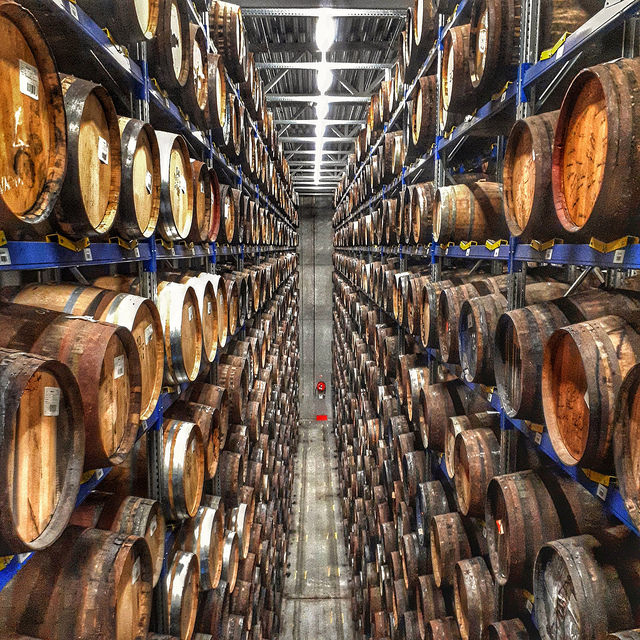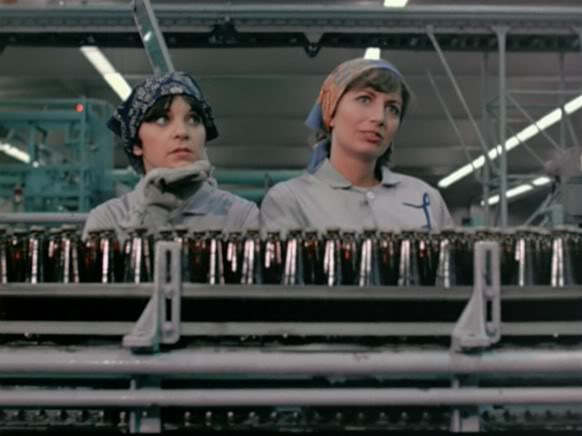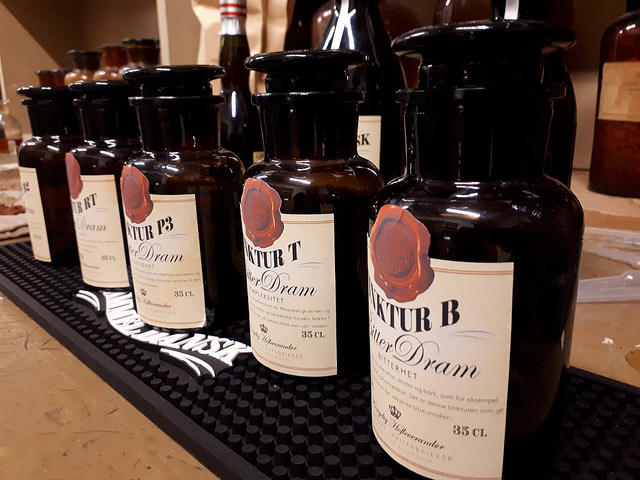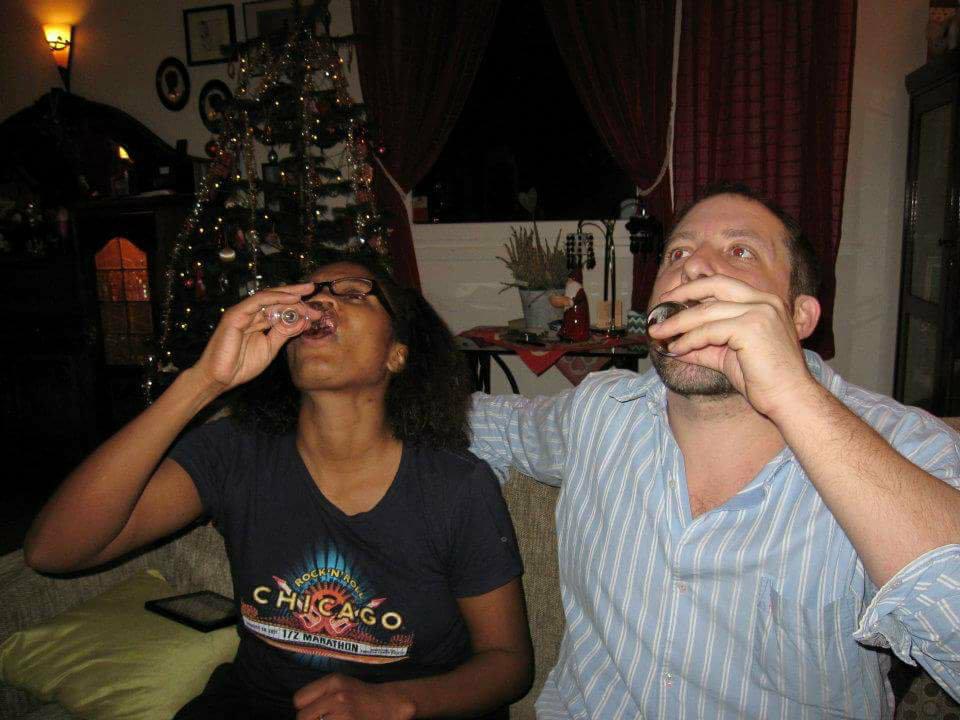Skål! A visit to the home of aquavit, Norway’s storied liqueur
Some things are uniquely Norwegian: The world’s greatest cheese slicer, dominating the Winter Olympics and aquavit.
Aquavit, which means water of life, is a Norwegian liqueur served year-round, but is most popular at special occasions such as Christmas or May 17, Norway’s Constitution Day.
I’ve been drinking this schnapps at least once a year for the past 18 years. Even when we lived in the States, we always had a bottle on hand, always happy to give our friends a taste.
I was thrilled when my husband scored us a visit to the world’s largest producer of aquavit. The company, called Arcus, has a 517,000-square-feet (48,000-square-meter) facility, which we toured, and naturally there was a tasting afterward, but more on that later.

This temperature-controlled warehouse at Arcus has about 8,000 oak barrels of the Norwegian spirit, aquavit.
Aquavit is a caramel-colored, spicy spirit often served in small tulip-shaped glasses. Its origins trace back to the early 19th century when barrels of it were sent to the East Indies, but it tasted so bad no one there wanted to drink it. The aquavit was then shipped back to Norway and it turned out that the long journey drastically improved the taste.
Today the Linie brand still sends all of its aquavit across the equator and back.
Upon walking into the Arcus lobby, there’s a small interactive museum area on the history of alcohol in Norway. I learned juicy little tidbits such as how Norwegians imbibed with their own moonshine as early as the 1500s.
Over time, making alcohol became more organized and by 1833, Norway had 10,000 or so registered distilleries. Government regulation during the next 20 years pared that number down to around 40. Then came Prohibition in 1919, which thankfully ended in 1927.
The Arcus production plant doesn’t only make aquavit. It is also where wine and other spirits are bottled. Some of the bottling machines on the manufacturing floor reminded me of the TV Show Laverne & Shirley and I had to resist the urge to put my glove on one of the bottles going by.

The Laverne & Shirley show ran from 1976 to 1983. In the opening sequence Laverne put her glove on a bottle on the production line at the bottling plant where the women worked. The jostling bottle made it look like the glove was waving.
Our tour in December included a trip to Arcus’ ingredient room where we learned about the different spices that go into the water of life. The liqueur’s dominant taste is carraway, which you could smell before arriving at the ingredients room. Inside was a pungent mix of dill, cinnamon, cardamom, fennel, coriander, lemon peel, and more. We also tasted a series of bitters, where our guide put a drop on our closed fist and we licked it off. Even though it was just a drop, it was crazy strong.

The bitters we tasted.
Next we visited a production area that included these gargantuan steel vats of wine, where each one contained 10,000 liters of wine. I thought I heard angels singing when I first spotted those wine tanks. We also got to check out the coppery contraption where the aquavit is made. With its bendy pipes and bulbous parts it looked like something out of a Dr. Seuss book. (Think of the Star-On Machine used by the Sneetches in that Dr. Seuss story.)
My favorite though, were all the oak barrels. Arcus makes a special barrel of aquavit for important events concerning the Royal family, such as births and weddings. There are also private clubs that have their own barrels of aquavit.
Plus there’s a vast warehouse that has misters and is temperature-controlled to perfectly house about 8,000 barrels of aquavit, some of which are more than 100 years old. Standing on the platform overlooking the rows upon rows of barrels was actually pretty breathtaking.
Finally, we settled into the tasting room and were treated to several types of aquavit to sample. Our guide led us through a series of the liqueur, including different ones from Linie, Skrei and the 2017 Christmas aquavit. Each year a special Christmas aquavit is created, using drops from all the previous years of Christmas aquavit as well as new ingredients.
The 2017 version is generally considered better than other recent iterations. At the tasting, that Christmas one was Hubby’s favorite. I, however, preferred the Skrei based on the fact that it burned the least going down.
One of my favorite parts of drinking aquavit is right before that first swig. You raise your glass and exclaim “Skål! (pronounced skohl.) This toast dates back to the Vikings and literally means “cup” or “bowl.” I just like how heartily the usually quiet Norwegians proclaim it.
So if you ever have a chance to try some aquavit skål and enjoy!

My brother-in-law and I keeping up with the Norwegians.

As always, i do enjoy the lovely pieces of history that you so brilliantly present. This time a slso had a good laugh. I do admire you solid knowledge of everything ypu present.. thank you. mMelanie
Thanks Gry! I’m glad that you enjoy my writing!I certainly try to do a good job, especially when talking about Norwegian things. We wouldn’t have known about the tour if it weren’t for you. It really is a great experience!
I came to visit your blog from Wordless Wednesday, however when I saw the word Skal, I had to investigate.
My parents would always toast:
Mein Skol,
Dein Skol,
Alle Vakkera Flikka Skol.
(Translated:
My health,
your health,
all beautiful ladies’ health.)
LOL..thank you for the reminder!
– Lisa
Ha! That’s great! Do your parents have Scandinavian roots? Thank you for visiting!!